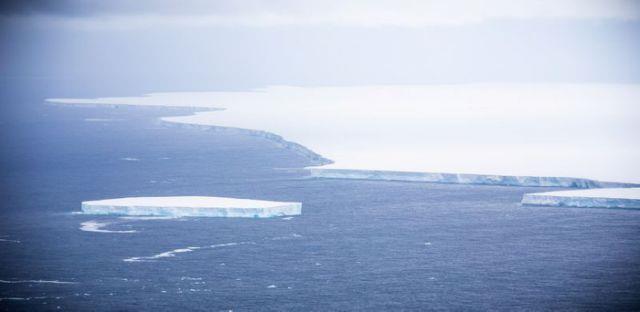ATLANTIC, Dec. 10 (Reuters) - An enormous iceberg is heading toward South Georgia Island in the southern Atlantic, where scientists say a collision could devastate wildlife by threatening the food chain.
Scientists have long been watching this climate-related event unfold, as the iceberg - about the same size as the island itself – has meandered and advanced over two years since breaking off from the Antarctic peninsula in July 2017.
The peninsula is one of the fastest-warming places on Earth, registering a record high temperature of 20.75 degrees Celsius (69.35 degrees Fahrenheit) on Feb. 9. The warming has scientists concerned about ice melt and collapse leading to higher sea levels worldwide.
The gigantic iceberg - dubbed A68a - is on a path to collide with South Georgia Island, a remote British overseas territory off the southern tip of South America. Whether that collision is days or weeks away is unclear, as the iceberg has sped up and slowed down with the ocean currents along the way, said Geraint Tarling, a biological oceanographer with the British Antarctic Survey who has been tracking the icy mass.
A collision, while looking increasingly likely, could still be avoided if the currents carry the iceberg past the island, Tarling said.
The currents “still have the power to take this iceberg in one direction or another away from South Georgia,” Tarling said in an interview on Wednesday. “But it is really, really close, less than 50 kilometers away from the south shelf edge. That’s getting so close that it’s almost inevitable.”
Images captured by a British Royal Air Force aircraft and released on Tuesday show the magnitude of the monstrous, 4,200-square-km (1,620-square-mile) iceberg, its surface carved with tunnels, cracks and fissures. A number of smaller ice chunks can be seen floating nearby.
“The sheer size of the A68a iceberg means it is impossible to capture its entirety in one single shot,” British officials said in a statement.
Still, the berg is diminished from its original size of 5,800 square km (2,240 square miles), measured when the mass broke off from Antarctica’s Larsen C ice shelf 2-1/2 years ago.
Scientists fear that the iceberg, in hitting the island, could crush marine life on the sea floor, including coral, sponges and plankton. Should it lodge at the island’s flank, it could block seals along with the island’s 2 million penguins from their normal foraging routes.
Some species, like King penguins, travel for up to 16 days to find food. If the berg gets in the way, that foraging trip could take longer.
“And that’s unlikely to be sustainable. The chicks will start to lose mass,” Norman Ratcliffe, a seabird biologist in the Ecosystems Division of the British Antarctic Survey, said in an interview on Wednesday.
A68a could also be an obstacle to government ships conducting fishery patrols and surveillance around South Georgia and the nearby South Sandwich Islands, British officials said.





